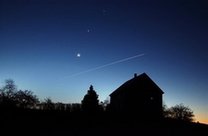感恩节是家庭团聚的传统节日,而今年,金星、木星和月球也打算聚在一起共度佳节。据《天空与望远镜》杂志高级编辑艾伦称,自感恩节当晚开始,金星和木星便会相向移动,到本周日和下周一,二者之间大概会有一指长的距离。到下周一晚间,一轮新月也将现身其中,为我们带来三星同辉的奇幻景象。专家表示,如果天气晴好的话,人们不用借助任何设备便可观测到这一景象。

|

|
|
The three brightest objects in the night sky — Venus, Jupiter and a crescent moon — will crowd around each other for an unusual group shot
|
It's not just families that are getting together this Thanksgiving week. The three brightest objects in the night sky — Venus, Jupiter and a crescent moon — will crowd around each other for an unusual group shot.
Starting Thanksgiving evening, Jupiter and Venus will begin moving closer so that by Sunday and Monday, they will appear 2 degrees apart, which is about a finger width held out at arm's length, said Alan MacRobert, senior editor at Sky and Telescope magazine. Then on Monday night, they will be joined by a crescent moon right next to them, he said.
Look in the southwestern sky around twilight — no telescope or binoculars needed. The show will even be visible in cities if it's a clear night.
"It'll be a head-turner," MacRobert said. "This certainly is an unusual coincidence for the crescent moon to be right there in the days when they are going to be closest together."
The moon is the brightest, closest and smallest of the three and is 252,000 miles away. Venus, the second brightest, closest and smallest, is 94 million miles away. And big Jupiter is 540 million miles away.
The three celestial objects come together from time to time, but often they are too close to the sun or unite at a time when they aren't so visible. The next time the three will be as close and visible as this week will be Nov. 18, 2052, according to Jack Horkheimer, director of the Miami Space Transit Planetarium.
But if you are willing to settle for two out of three — Venus and the crescent moon only — it will happen again on New Year's Eve, MacRobert said.
(Agencies)

Vocabulary:
head-turner: 引人注目的(人或事)
(英语点津 Helen 编辑)